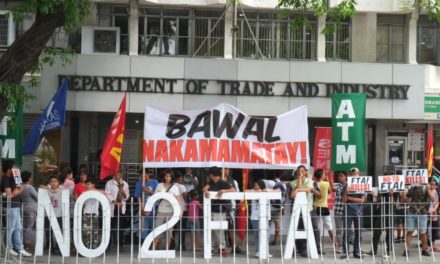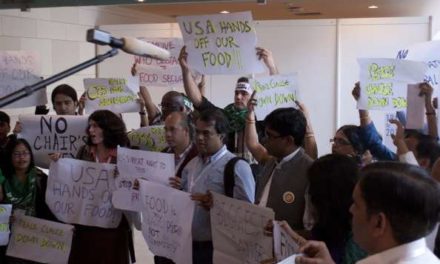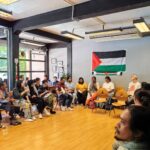GENEVA, 28 June, 2006: After an intense seven week process of continuous negotiations in Geneva, the chairs of the agriculture and NAMA (non-agricultural market access) negotiating committees, NZ Ambassador Crawford Falconer and Canada's Donald Stephenson, submitted their draft texts to the WTO members on 22 July.
The agriculture text reflects a phenomena that has not been seen in the WTO in the past 6 years, where Crawford Falconer actually faithfully reflected the positions of members, capturing the existing divergences (in 750 brackets), and consensus where these exist. This is a welcome departure from the WTO's modus operandi of the recent past – where chairs manafactured non-existent consensus, based on their own (often biased) judgments, and relying on manipulation by the powerful to ram these through. For example, the draft texts that led to the inconclusive Cancun Ministerial, and Annex C before the Hong Kong Ministerial. Canadian Ambassador Stephenson's NAMA text, according to the NAMA 11 group of developing countries, did not accurately reflect their positions, and in some areas (for example, on sectoral tariff cuts), was misleading.
In submitting their texts, the chairs said that the process is now in the hands of Director General Pascal Lamy as chair of the trade negotiations committee (TNC).
Curiously, despite all the work involved in producing these texts, and in spite of the anticipation, since 22 July there has been no real substantive discussions of these drafts. Instead, this week Pascal Lamy intervened with his own process, which essentially sidelines the chairs' texts.
LAMY'S GREEN ROOM MEETINGS
A series of green room meetings of about thirty ambassadors, convened by Lamy since 26 June, have set in place plans for the mini ministerial the WTO secretariat is convening later this week (starting 29 June). These were the issues discussed:
1) It is reported that, according to Lamy, the mini ministerial and other informal meetings from the 29 June – 2/3 July, are intended to conclude modalities so that members can draft their schedules. However, the plans seem to be headed towards resolving only partial rather than full modalities at least in June, focusing mainly on the triangle of issues the Director General seems to think are the most critical: i) market access in agriculture (requiring movement from the EU); ii) domestic supports in agriculture (awaiting movement from the US); iii) tariff cuts in NAMA (requiring commitments from Brazil and India).
A "sequence" of issues to be discussed in agriculture and NAMA in the mini ministerial has emerged from the green room. (See annex below.) In April this year, many members were vehemently opposed to Lamy's suggestion of partial modalities for an April mini ministerial. This led to the cancellation of the mini ministerial. This time around, there is careful wording to justify this "sequencing" – that these are not priority issues, but is a sequence of issues to be discussed. Some issues, it is reasoned, unlock others.
In the green room meeting of 27 June, there was no consensus on what the partial list of issues should be. Some African countries suggested putting preference erosion on the agriculture list, others wanted export competition and tariff caps to be listed. They were cautioned against ending up with a "Christmas tree". The Director General said that he would revise the list and re-issue it on the afternoon of 27 June. However, it is not expected that there will be too many changes.
2) Lamy also talked about "arriving at a landing zone" of reaching real cuts in domestic supports and new trade flows (that is, tariff cuts should really cut into the applied rates). He seems to have acknowledged that whilst "new trade flows" is not a reflection of the Doha mandate, these issues have emerged in the course of the negotiations.
"New trade flows" raised many concerns. He was told by some ambassadors in the green room that his "landing zone" was off target and that it should be "development" and "less than full reciprocity" (a concept used in the NAMA negotiations meaning that developing countries should take less percentage tariff cuts than developed countries). Others however felt that Lamy's "landing zone" was a fair reflection of the mandate.
3) The EC said they hoped the "exchange rate between the issues" would become clear and would be the subject of discussions at the mini ministerial. That is, what are members willing to pay, what do they want to get, and what will be the price. (Developing country negotiators wonder if their ministers will be familiar enough with the technical details to navigate such discussions.)
The issue of green room meetings not going through the night was also raised. Lamy apparently only vaguely promised that he would not push them beyond a certain point.
REACTIONS FROM DEVELOPING COUNTRY MEMBERS
1) Sequencing of issues will marginalise developing countries' concerns
In the corridors of the WTO, some developing country delegates have questioned if Lamy's triangle of issues, which is essentially what the agreed sequencing amounts to, is the best approach for developing countries. Says one African delegate,
"In the triangle, more emphasis is placed on market access, and there is nothing on development. The special products (SP) and special safeguard mechanism (SSM) issues are seen as 'by the way issues'. This approach is not right. On preferences, Lamy has said that it would be easier to resolve preferences once the formula has been agreed to. But who will be there to listen to us once the formula is agreed?
"If we hold up on SP and SSM, we are in trouble. We will be told that we are withholding consensus and we will be blamed. If we agree on partial modalities focusing on market access and leaving development issues behind, we will be kissing these development issues goodbye."
2) Questions around the lack of accountability in the green room process
A whole range of issues around procedures and the lack of accountability of the process have also been raised in corridor discussions. The critieria for who gets invited to the green room meetings – arranged by the highest echelons in the secretariat — is completely unknown to the members. The co-ordinators of the developing country regions or groupings are usually included, as are co-ordinators of issue groups such as Benin on behalf of the Africa Group; Zambia for LDCs; Mauritius representing the ACP; and Indonesia representing G33. Incidentally all the G6 members are present (US, EU, Brazil, India, Japan, Australia). Some kind of regional representation is also part of the selection criteria. According to some, it works out to be about seven from each key region. There were seven Africans in the 27 June morning green room meeting.
There has never been a decision in the WTO that a co-ordinator negotiates on behalf of the group, yet in practice, this is assumed by the Secretariat, raising the following problems:
i) There is no detailed agenda of what the green room meeting will discuss prior to its occurrence, so that it is impossible for the co-ordinators to have consulted with their groupings ahead of time, or to speak on behalf of their group within the boundaries of a clear mandate provided by the group.
According to one delegate, "I had no idea on Monday morning (green room meeting on 26 June), that we were going to develop a list of issues for ministers to discuss. I could not tell that this was coming until I saw Mr Lamy."
ii) There is no in-built structure of accountability in the green room process to facilitate such group representation.
One delegate lamented, "Who is in the green room? I never know if I will be in the green room this week or next. Where are the minutes of the green room? What is the agenda to be discussed in the green room?
"It is assumed that those inside will speak on behalf of others outside. But there are no minutes and no structure of accountability. How do others know that I am representing them inside? What is the structure of accountability? These issues are fundamental and they pertain to the structure, process and legitimacy of the organisation."
Another delegate also questioned the issue of representation in the green room.
"I don't know how the seven (Africans) are chosen. Why is it that (country x) used to be a part of the green room but is no longer there? On what basis was that decision made?
"It is not good enough to push for representation but with no guidelines as to how to be accountable to these groups. Since there are no minutes from the green room, I don't accept what comes out because I do not know what my representative has said inside. My representative can also say that he/she had nothing to do with the outcome."
The orchestration of the negotiations between the green room and the plenary is also seen as a deliberate attempt to force through decisions from the green room, by-passing the larger membership. There is usually insufficient time between the green room and the plenary for co-ordinators to consult with their groups (as was the case in Hong Kong). A delegate laments: "How can the green room conclude at five to twelve, and the plenary take place at twelve?"
iii) Green room: effectively, the decision-making body in the WTO
The green room is not a formal decision making structure – as Lamy argues – and that in theory, members can block a consensus in the TNC or general council. However, developing country delegates have a different view:
"We know that a mini ministerial is not formal. But it does make decisions informally and in practice. Formally, the green room is not the ultimate decision making forum, but from the past, we have seen results coming out of this green room and taken to the formal TNC and rubber stamped."
3) Lamy and the green room texts
Lamy may refrain from issuing his own text, since there is so much opposition to this idea in Geneva. However, negotiators think that such texts are already being cooked by the Secretariat (and others), and will be smuggled into the green room, emerging not as Lamy texts but as green room texts.
An African delegate sums: "This process is terrible. You know, those days when we used to say that this is a rich man's club? I don't think anything has changed since. The process in the end will decide the substance."
If Pascal Lamy and the Secretariat imagine that they are conducting a bottom up, inclusive process (as they seem to think), they are deluding themselves. Many delegates are deeply frustrated with this process: their inability to influence the decisions; the, at best, patchy information flow from the green room; procedures, or the lack thereof, calculated to make it impossible for group representatives to be effectively accountable to their groups. There may or may not be revolt in the ranks in June and July. But it does not take a rocket scientist to know that a non-inclusive process designed to ram through certain interests, undermining development, will eventually have a blowback effect.
* Aileen Kwa is a research associate with Focus on the Global South based in Geneva. She is co-author with Fatoumata Jawara of "Behind the scenes at the WTO", Zed Books, 2004. She can be contacted at








